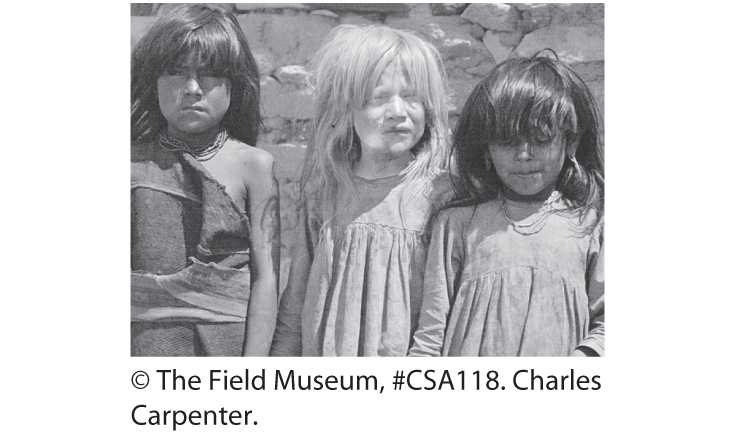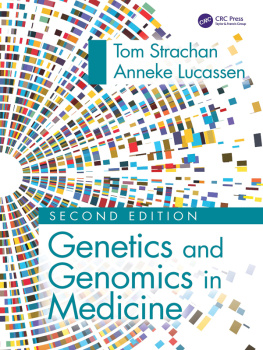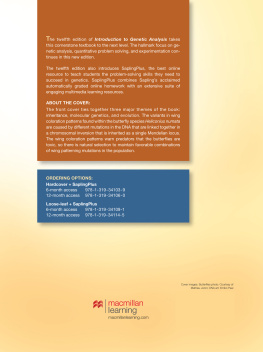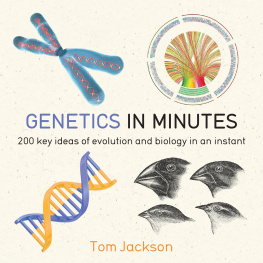Contents
Landmarks
List of Figure
List of Tables

The book cover shows a string of helical D N A wrapped around nucleosomes. Text at the bottom right reads, Benjamin A. Pierce.
CHAPTER Introduction to Genetics

A Hopi pueblo on Black Mesa. Albinism, a genetic condition, arises with high frequency among the Hopi people and occupies a special place in the Hopi culture.
Albinism in the Hopis
Rising a thousand feet above the desert floor, Black Mesa dominates the horizon of the Enchanted Desert and provides a familiar landmark for travelers passing through northeastern Arizona. Black Mesa is not only a prominent geological feature but also, more significantly, the ancestral home of the Hopi Native Americans. Fingers of the mesa reach out into the desert, and alongside or on top of each finger is a Hopi village. Most of the villages are quite small, having only a few dozen inhabitants, but they are incredibly old. One village, Oraibi, has existed on Black Mesa since 1150 C.E. and is the oldest continuously occupied settlement in North America.
In 1900, Ale Hrdlika, an anthropologist and physician working for the American Museum of Natural History, visited the Hopi villages of Black Mesa and reported a startling discovery. Among the Hopis were 11 white peoplenot Caucasians but white Hopi Native Americans. These Hopis had a genetic condition known as albinism ().

1.1 Albinism among the Hopi Native Americans. The Hopi girl in the center of this photograph, taken around 1900, displays albinism.
Albinism is caused by a defect in one of the enzymes required to produce melanin, the pigment that darkens our skin, hair, and eyes. People with albinism either dont produce melanin or produce only small amounts of it and, consequently, have white hair, light skin, and no pigment in the irises of their eyes. Melanin normally protects the DNA of skin cells from the damaging effects of ultraviolet radiation in sunlight, and melanins presence in the developing eye is essential for proper eyesight.
The genetic basis of albinism was first described by the English physician Archibald Garrod, who recognized in 1908 that the condition was inherited as an autosomal recessive trait, meaning that a person must receive two copies of an albino mutationone from each parentto have albinism. In recent years, the molecular nature of the mutations that lead to albinism has been elucidated. Albinism in humans is caused by a mutation in any one of several different genes that control the synthesis and storage of melanin; many different types of mutations can occur at each gene, any one of which may lead to albinism. The form of albinism found among the Hopis is most likely oculocutaneous albinism (albinism affecting the eyes and skin) type 2, caused by a defect in the OCA2 gene on chromosome 15.
The Hopis are not unique in having people with albinism among the members of their tribe. Albinism is found in almost all human ethnic groups. It is described in ancient writings and has probably been present since humankinds beginnings. What is unique about the Hopis is the high frequency of albinism in their population. In most human groups, albinism is rare, present in only about 1 in 20,000 individuals. In the villages on Black Mesa, it reaches a frequency of 1 in 200, a hundred times higher than in many other populations.
Why is albinism so frequent among the Hopis? The answer to this question is not completely known, but geneticists who have studied albinism in the Hopis speculate that the high frequency of the albino mutation is related to the special place that albinism occupied in the Hopi culture. For much of their history, the Hopis considered members of their tribe with albinism to be important and special. Having a number of people with albinism in ones village was considered a good sign, a symbol that the people of the village contained particularly pure Hopi blood. Members of the tribe with albinism performed in Hopi ceremonies and held positions of leadership, often as chiefs, healers, and religious leaders.
Hopis with albinism were also given special treatment in everyday activities. The Hopis have farmed small garden plots at the foot of Black Mesa for centuries. Every day throughout the growing season, the men of the tribe trekked to the base of Black Mesa and spent much of the day in the bright southwestern sunlight tending gardens of corn and vegetables. With little or no melanin pigment in their skin, people with albinism are extremely susceptible to sunburn and have an increased incidence of skin cancer when exposed to the sun. Furthermore, many dont see well in bright sunlight. Therefore, the male Hopis with albinism were excused from farming and allowed to remain behind in the village with the women of the tribe, performing other duties.
Throughout the growing season, the men with albinism were the only male members of the tribe in the village with the women during the day, and thus they may have enjoyed a mating advantage, which helped pass on their albino genes. In addition, the special considerations given to Hopis with albinism allowed them to avoid the detrimental effects of albinismincreased skin cancer and poor eyesight. The small size of the Hopi tribe probably also played a role by allowing chance to increase the frequency of the albino mutation. Regardless of the factors that led to the high frequency of albinism, the Hopis clearly respected and valued the members of their tribe who possessed this particular trait. Unfortunately, people with genetic conditions in many societies are often subject to discrimination and prejudice. TRY

Think-pair-share
- Albinism occupied a special place in the Hopi culture; individuals who possessed this trait were valued by members of the tribe. What are some examples of genetic traits that, in contrast, sometimes result in discrimination and prejudice?
- Albinism in humans can be caused by mutations in any one of several different genes. This situation, in which the same phenotype may result from variation in several different genes, is referred to as genetic heterogeneity. Is genetic heterogeneity common? Are most genetic traits in humans the result of variation in a single gene, or are there many genetic traits that result from variation in several genes, as albinism does?
is the study of heredity, how inherited variation is encoded, replicated, and expressed, and how it evolves over time. This definition encompasses the three major subdivisions of genetics: transmission genetics, molecular genetics, and population genetics. The study of heredity and inherited variation is one of the most rapidly advancing areas of science, with important new discoveries reported every month. Look at almost any major news source, and chances are that you will see articles related to genetics: on the sequencing of new genomes, such as those of the sunflower, barley, the axolotl, and Darwins finches; on the discovery of genes that affect major diseases, including amyotrophic lateral sclerosis (ALS), depression, and cancer; on analyses of DNA from long-extinct organisms, such as a 700,000-year-old Pleistocene horse; or on the identification of genes that affect birth weight, skin pigmentation, height, and learning ability in humans. Even among advertisements, you are likely to see ads for genetic testing to determine a persons ancestry or the pedigree of your dog. These new findings and applications of genetics often have significant economic and ethical implications, making the study of genetics relevant, timely, and interesting.












 Think-pair-share
Think-pair-share